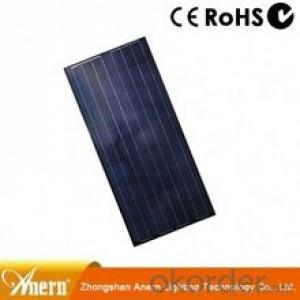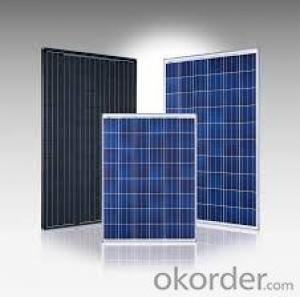Monocrystal Solar Energy Cell 156*156mm Efficiency with Low Price
- Loading Port:
- Tianjin
- Payment Terms:
- TT or LC
- Min Order Qty:
- 10 pc
- Supply Capability:
- 1000000 pc/month
OKorder Service Pledge
OKorder Financial Service
You Might Also Like
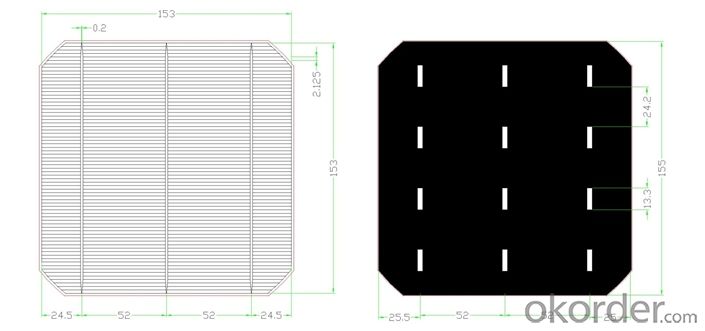
Monocrystal Solar Energy Cell
type:156M
appearance:156×1565㎜±0.5mm;diagonal:R=100mm
Main fence wide:1.4-1.5mm back electrode wide:2-2.5mm
Fence line qty:90
Cell thickness:220um±20um
Eff(%) | 18.00- 18.10 | 18.10- 18.20 | 18.20- 18.30 | 18.30- 18.40 | 18.40- 18.50 | 18.50- 18.60 | 18.60- 18.70 | 18.70- 18.80 | 18.80- 18.90 | 18.9- 19.0 | 19.1- 19.1 | 19.1- 19.2 |
Pm(W) | 4.30 | 4.33 | 4.35 | 4.37 | 4.40 | 4.42 | 4.44 | 4.47 | 4.49 | 4.52 | 4.54 | 4.56 |
Isc(A) | 8.71 | 8.73 | 8.76 | 8.77 | 8.78 | 8.82 | 8.83 | 8.85 | 8.86 | 8.88 | 8.9 | 8.93 |
Im(A) | 8.19 | 8.21 | 8.24 | 8.26 | 8.30 | 8.33 | 8.35 | 8.39 | 8.42 | 8.45 | 8.47 | 8.51 |
Voc(V) | 0.630 | 0.631 | 0.632 | 0.633 | 0.634 | 0.634 | 0.635 | 0.636 | 0.637 | 0.637 | 0.638 | 0.64 |
Vm(V) | 0.527 | 0.528 | 0.529 | 0.531 | 0.531 | 0.532 | 0.534 | 0.534 | 0.535 | 0.536 | 0.537 | 0.538 |
FF(%) | 78.6 | 78.7 | 78.8 | 79.0 | 79.2 | 79.3 | 79.5 | 79.6 | 79.8 | 80 | 80 | 80 |

remark:our company cells as per working current concentrate principle,separate the first and the second grade
Factory Picture of Solar Cells
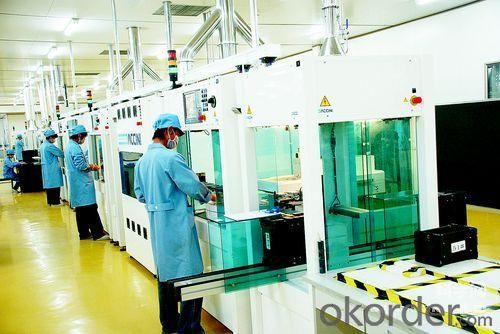
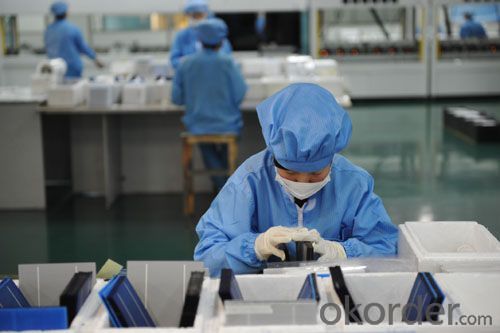
FAQ
We have organized several common questions for our clients,may help you sincerely:
What’s price per watt?
A: It’s depends on the quantity, delivery date and payment terms of the order. We can talk further about the detail price issue. Our products is high quality with lower price level.
Can you tell me the parameter of your solar cells?
We have different series of cells with different power output, both from c-si to a-si. Please take our specification sheet for your reference.
How do you pack your products?
We have rich experience on how to pack the panels to make sure the safety on shipment when it arrives at the destination.
Can you do OEM for us?
Yes, we can.
How long can we receive the product after purchase?
In the purchase of product within three working days, We will arrange the factory delivery as soon as possible. The perfect time of receiving is related to the state and position of customers. Commonly 7 to 10 working days can be served.
Brief introduction of Monocrystal Solar Energy Cell
Silicon rods, materials performance indicators in order to reduce production costs, and now terrestrial applications such as solar cells using solar grade somewhat relaxed. Some also use semiconductor device processing materials and discard the head and tail of silicon materials, solar cells drawn into complex dedicated silicon rods.
The silicon rods cut into pieces, usually 0.3 mm thick sheet. Processing solar cells, the first doping and diffusion in silicon, a trace amount of dopant is generally boron, phosphorus, and antimony. Diffusion is carried out in a quartz tube into a high-temperature diffusion furnace. Thus formed P> N junction on the wafer. Then using a screen printing method, fine with a good paste into a grid line printed on the wafer, after sintering, while forming the back electrode and the surface coated with antireflection gate line source to prevent a large number of photons it is reflected off the smooth surface of the wafer. Thus, the monomer Monocrystal solar energy cells are produced. After single-chip random testing can be assembled according to the required specifications into a solar cell module (solar panel) by the method of series and parallel to a certain output voltage and current.
Difference between Monocrystal Solar Energy Cell and polycrystalline silicon solar panels:
Polycrystalline silicon solar cells and Monocrystal solar energy cells is no different. Life and stability of polycrystalline silicon solar cells and Monocrystal solar energy cells are good. Although the average conversion efficiency of silicon solar cells is higher than the average conversion efficiency of polycrystalline silicon solar cells of about 1%, but because of Monocrystal solar energy cells can be made quasi-square (four to the top of the arc), when the composition of the solar cell module when there is a part of the area filled up, and polycrystalline silicon solar cells are square, there is no problem, so the efficiency of the solar cell module is the same.
In addition, because the manufacturing process two types of solar cell materials is not the same, polycrystalline silicon solar cell manufacturing process energy consumed than Monocrystal solar energy cells is about 30% less.
- Q:How are solar cells affected by temperature?
- Solar cells are negatively affected by high temperatures as they experience a decrease in efficiency due to increased resistance and thermal losses. This is because higher temperatures lead to increased electron-hole recombination rates and decreased open-circuit voltage. However, low temperatures can also reduce solar cell performance due to decreased conductivity and increased series resistance.
- Q:Can solar cells be used to power air conditioning systems?
- Yes, solar cells can be used to power air conditioning systems. Solar panels can generate electricity from sunlight, which can then be used to power air conditioning units. However, the size and efficiency of the solar panel system would need to be carefully considered to ensure it can generate enough electricity to meet the demands of the air conditioning system.
- Q:Can solar cells be used for water heating applications?
- Yes, solar cells can be used for water heating applications. Photovoltaic (PV) solar cells can convert sunlight directly into electricity, which can then be used to power electric water heaters. Additionally, solar thermal collectors can be used to heat water directly by absorbing sunlight and transferring the heat to the water. Both methods offer efficient and sustainable alternatives to traditional water heating systems.
- Q:How do solar cells perform in regions with high levels of air pollution?
- Solar cells generally perform less efficiently in regions with high levels of air pollution. Air pollution can block sunlight and reduce the amount of light reaching the solar cells, thereby reducing their performance. Additionally, pollutants in the air can settle on the surface of the solar cells, forming a layer of dust or dirt, which further reduces their efficiency. Regular cleaning and maintenance of solar panels are necessary in polluted regions to ensure optimal performance.
- Q:Are solar cells recyclable?
- Yes, solar cells are recyclable. They contain valuable materials like silicon, glass, and metal, which can be extracted and reused. Recycling solar cells helps reduce waste and conserves resources.
- Q:How do solar cells perform in extreme weather conditions?
- Solar cells can perform well in extreme weather conditions, including high temperatures and cold temperatures, as long as they are properly designed and installed. However, extreme weather events such as heavy snow or hailstorms can potentially damage solar panels. Overall, solar cells are quite resilient and can continue to generate electricity even in challenging weather conditions.
- Q:Can solar cells be used for powering electric vehicle charging stations?
- Yes, solar cells can be used for powering electric vehicle charging stations. Solar panels can convert sunlight into electricity, which can then be used to charge electric vehicles. This renewable energy source is ideal for charging stations as it reduces reliance on traditional power grids and reduces carbon emissions.
- Q:How does the size of a solar cell affect its performance?
- The size of a solar cell directly affects its performance. Generally, larger solar cells have the ability to generate more electricity compared to smaller ones. This is because larger cells have a greater surface area to capture sunlight, resulting in a higher conversion efficiency and increased power output. Additionally, larger cells are better at handling heat dissipation, which can improve their overall performance and durability.
- Q:Can solar cells be used for powering remote mining operations?
- Yes, solar cells can be used for powering remote mining operations. Solar power is a viable and sustainable energy source that can be harnessed in remote areas where access to traditional electricity grids is limited or non-existent. Installing solar panels at mining sites can provide a reliable and cost-effective source of power for various operations such as machinery, lighting, and communication systems. Additionally, solar power reduces dependence on fossil fuels, minimizing environmental impact and promoting clean energy solutions.
- Q:How to explain to students how the solar cells are made?
- The best way to explain that to students is to take them to a solar cells workstation if possibile.
1. Manufacturer Overview |
|
|---|---|
| Location | |
| Year Established | |
| Annual Output Value | |
| Main Markets | |
| Company Certifications | |
2. Manufacturer Certificates |
|
|---|---|
| a) Certification Name | |
| Range | |
| Reference | |
| Validity Period | |
3. Manufacturer Capability |
|
|---|---|
| a)Trade Capacity | |
| Nearest Port | |
| Export Percentage | |
| No.of Employees in Trade Department | |
| Language Spoken: | |
| b)Factory Information | |
| Factory Size: | |
| No. of Production Lines | |
| Contract Manufacturing | |
| Product Price Range | |
Send your message to us
Monocrystal Solar Energy Cell 156*156mm Efficiency with Low Price
- Loading Port:
- Tianjin
- Payment Terms:
- TT or LC
- Min Order Qty:
- 10 pc
- Supply Capability:
- 1000000 pc/month
OKorder Service Pledge
OKorder Financial Service
Similar products
New products
Hot products
Hot Searches
Related keywords









